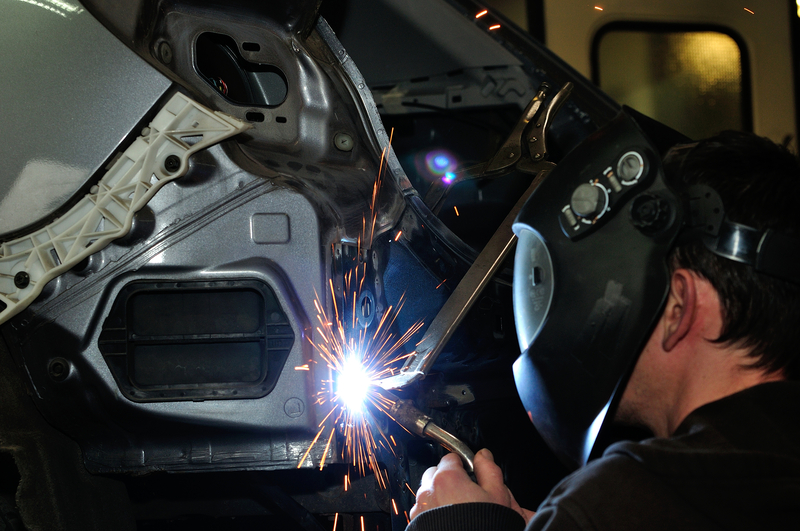When your vehicle has been in a fender bender and only has a few scuffs or a small dent, it’s tempting to breathe a sigh of relief and keep driving. But what if we told you that damage beneath the surface might be far more serious—and much more expensive—than what’s visible?
Even minor accidents can cause hidden damage that compromises your safety, your vehicle’s performance, and your wallet if left unchecked. Here’s why that unseen damage matters—and what you should do about it.
What Is Hidden Auto Body Damage?
Modern vehicles are designed with protective outer shells and crumple zones to absorb impact in a collision. While this helps protect occupants, it often means that structural or mechanical damage is concealed beneath panels and bumpers. In fact, many components are engineered to collapse or deform under stress—and those parts don’t always look broken from the outside.
A 2019 AAA study found that nearly 30% of drivers involved in a minor collision delayed or avoided repairs because the damage “didn’t seem that bad.” But even cosmetic-looking damage can mask serious internal issues.
Common Types of Hidden Collision Damage
Here are a few types of damage that frequently go unnoticed:
1. Frame and Structural Damage
Your car’s frame is its backbone. Even a low-speed collision can twist or bend it. Misalignment might not stop you from driving immediately, but it can weaken the vehicle’s structure and impact safety in future accidents. According to the National Highway Traffic Safety Administration (NHTSA), structural integrity is a key factor in crash survival rates.
2. Suspension and Steering Damage
Your vehicle’s suspension and steering components are delicate systems. Damage to tie rods, control arms, or shock absorbers may result in vibrations, uneven tire wear, or poor handling. But these symptoms can take weeks to appear, especially if the damage is subtle.
3. Electrical System Disruptions
Modern vehicles are full of sensors, wires, and control modules. A minor fender bender can knock a sensor loose or sever a wire, causing malfunctioning headlights, warning lights, or issues with traction control, braking, and even engine performance.
4. Airbag Sensor Malfunctions
Even if your airbags didn’t deploy during a collision, the sensors could have been damaged. These sensors help determine whether airbags should deploy in future crashes. A malfunction could mean the system fails when you need it most—or deploys unexpectedly.
5. Radiator and Cooling System Leaks
Your radiator or coolant lines are vulnerable in front-end collisions. Tiny cracks or pinhole leaks can go unnoticed until your engine overheats weeks later. According to CarMD’s 2023 Vehicle Health Index, cooling system failures are one of the top 10 most common (and costly) repairs when ignored.
6. Wheel and Axle Issues
Wheel alignment issues or bent axles can throw off your steering and cause uneven tire wear. Left untreated, these problems can reduce fuel efficiency and put stress on other components like your transmission and drivetrain.
Why Hidden Damage Is a Big Deal
Hidden damage isn’t just about aesthetics—it’s about safety, longevity, and cost.
A slightly bent frame may seem harmless, but it can:
- Alter your vehicle’s crash behavior.
- Interfere with airbag timing or deployment.
- Accelerate wear on parts like bushings, mounts, and tires.
- Void your vehicle’s warranty or lease agreement.
Delaying repairs often leads to more damage. What starts as a small issue can cascade into a major one if ignored. And from an insurance standpoint, failing to report or repair damage promptly can limit your ability to make a claim later.
How Do Auto Body Shops Detect Hidden Damage?
Professional collision repair shops use a variety of tools and techniques to uncover what the eye can’t see:
- Digital diagnostic scans detect errors in the vehicle’s computer systems.
- Laser measuring systems identify even the slightest frame misalignment.
- Test drives and suspension checks evaluate steering, braking, and alignment.
- Visual inspections under the hood and under the car catch small leaks or loose components.
Many of these steps are skipped by DIY repairs or shops that don’t specialize in collision damage. That’s why working with certified professionals matters.
“But It Drives Fine” Isn’t Always Reassuring
Just because your car turns on and moves doesn’t mean it’s roadworthy. Many hidden issues take time to reveal themselves. Think of it like a house after an earthquake—it might still stand, but that doesn’t mean the foundation is safe.
If your vehicle “pulls” to one side, makes strange noises, or has warning lights on—even weeks after an accident—those are red flags you shouldn’t ignore.
Insurance Implications of Hidden Damage
Insurance companies often cover hidden damage if it’s documented promptly and accurately. But if you delay inspection, they may deny future claims related to that same accident.
A post-collision inspection ensures:
- All damage is included in the estimate.
- You receive the full compensation you’re entitled to.
- Your vehicle is repaired to manufacturer safety standards.
What Should You Do After an Accident?
Here’s a quick checklist—even if it’s a minor collision:
- Document the accident. Take photos, gather contact info, and file a police report if needed.
- Contact your insurance. File a claim and request an inspection.
- Schedule a professional estimate. Look for a certified shop that offers digital scanning and thorough diagnostics.
- Ask questions. Make sure your shop checks for structural damage, alignment, and sensor function.
It’s What You Can’t See That Matters Most
When it comes to vehicle damage, appearances are deceiving. A tiny dent could be hiding serious trouble. Don’t risk your safety or your wallet by assuming everything’s fine just because it “looks okay.”
Choosing a reputable, experienced auto body shop means your car gets more than just cosmetic care—it gets the peace of mind that comes from knowing every hidden detail has been addressed.

